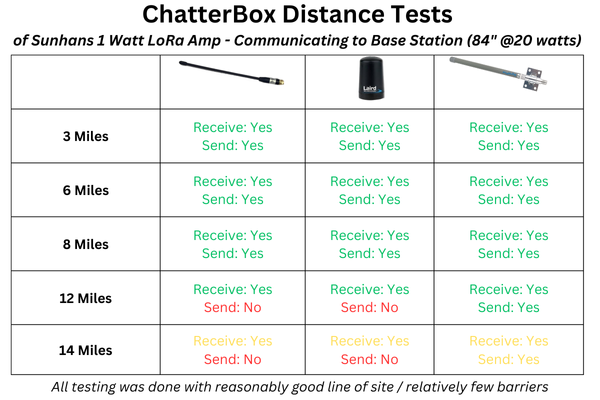Sunhans LoRa Bi-Directional Amplifier
The Sunhans 1 watt LoRa amplifier is a very interesting piece of hardware for several reasons.
It’s the maximum power you can transmit at in the US, without having an amateur radio license
It doesn’t use much current and can easily be powered by a 12v battery
It is very stable and works quite well with ChatterBox
About This LoRa Amplifier
Specs
Cost (2025): $119.00 (Amazon)
Frequency: 902MHz-928MHz
Output Power: 39dBm (1W)
Gain: 16dB RX, 24 db TX
FCC Certified: Yes
Indicator LEDs: Green = Power, Blue = Activity
What’s Included
Amp (Mountable aluminum enclosure)
Power Supply - AC Only
Mesh / LoRa Amp Testing
Methodology
As a mesh communication firmware developer, my only interest is really whether this amp plays well with LoRa mesh applications. My testing is pragmatic and focuses on reliability of encrypted mesh deliveries (one way and 2 way) at various distances, and that is really all.
As you can see in the screenshots below, using the ChatterBox mesh firmware, I’m able to see a live view of which devices/nodes I’m receiving pings from. I’m also able to send messages, which return an ECDSA signed confirmation (shows as check mark), so I know for a fact the message was received and validated, without seeing the distant device.
My “Base Station” (basically a node)
All tests with different antennas and distances were done by viewing signal strength, attempting direct messages and broadcasts, and receiving direct messages/broadcasts from my fixed position base station. The base station is not really what I’m testing here, but rather what this 1 watt amp can is capable of. This base station isn’t the subject of these tests, but since it’s involved, I’m showing it here. It’s composed of a ChatterBox E-Paper Mesh Node, 20 watt amp, and 84” roof mounted omni antenna.
The Test Unit
For the test unit, I simply paired a ChatterBox T3S3 node with the Sunhans LoRa amp and a 12v LiPo battery to power the amp (and keep the node charged).
I put all that into an easy-to-transport enclosure, and left the antenna connector accessible where I could easily swap the aforementioned antennas at various locations.
I’ve since turned this unit into an outdoor solar node, mounted to my shed, for testing other combinations in the future.
Antennas
The “base station” (node) is common across all tests. I try various antennas, as shown below, paired with the Sunhans 1 Watt LoRa antenna to compare how well the amp works with the firmware and antenna combo.
Base Station Antenna
The “base station” (node) is common across all tests. I try various antennas, as shown below, paired with the Sunhans 1 Watt LoRa antenna to compare how well the amp works with the firmware and antenna combo.
This node is generally what I do distance tests with for simplicity.
It’s running with an 84” Signal Plus Omni antenna (source: Amazon).
Rubber-Ducky 17cm
This is an excellent antenna for mobile purposes. It plays very well with ChatterBox firmware.
You can find them on Amazon for around $16-18.
Laird Phantom Stealth
A very stealthy option (you can barely see it mounted on my car), but very good performer.
This is a great option for car-mounted antennas. They’re so stealthy, I can’t find any sources that have them in stock currently.
Signal Plus 15” Omni
These are great antennas for mounting to a wall or mast, while not being overly large.
They are weatherproof and extremely dependable performers for LoRa / mesh.
They come with cable and usually an SMA adapter. You can find them on Amazon for $30-40.
Results
The results of the Sunhans LoRa amplifier’s connectivity to the base station at varying distances are shown below.
As you can see, all pairs are generally able to receive encrypted/signed messages quite well at 12 miles. At 14 miles, the ability to receive is a little less consistent, but that’s not necessarily a problem, depending on your use case.
These tests were done on flat land in the midwest, before trees had bloomed in the spring.
If you were to repeat these tests where the node (or you) is positioned on a place with high visibility, such as a mountain top, I think you’d be able to do much better than the results show here, even without a highly amped base station like I have. The effect pf the base station amp in my test setup is mainly to allow penetration of obstructions.
Conclusion : Excellent LoRa Amp for Secure Mesh Comms!
When paired with a suitable antenna and LoRa mesh firmware that that has robust delivery capabilities, you are going to be very happy with the results you get from this amp.
You may find cheaper amps in this power range, but cheaper ones are no likely to perform nearly as well (I’ve tried some, and I’m still looking).
I plan to do more tests with the Sunhans paired with non-amped devices, such as a standard node or T-Deck Plus, as well as other devices connected with an identical 1 watt amp, to give you an idea of the maximum performance you can achieve without requiring amateur radio licensing.
Such testing has already been done intermittently by me (and others) but just not in a repeatable and well-documented manner.















